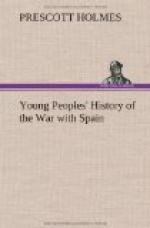“I remember one incident of the first day which showed how deadly was the fire of these machine guns. Away off, across the valley, we saw a clump of Spanish cavalrymen. I ordered the guns turned on them. They were so far away we had to use glasses to find them accurately, but when the little wheels began to turn, those who stood in the front line of the clump fell as grass falls before a mower, and it didn’t take the rest of those Spaniards long to get behind something.
“As the day wore on, and the troops kept climbing up the hill, Colonel Roosevelt, who had been watching the work of the Gatlings, came along and placed his light battery of two Colt machine guns and one dynamite gun in my command.”
You can get an idea of the deadly work of the Gatlings when I tell you that the fire of one of these guns is equal to that of one hundred and eighty riflemen, each discharging thirteen shots per minute.
The dynamite gun is the latest development in light artillery. One of them had been supplied to Roosevelt’s Rough Riders, or “Teddy’s Terrors,” as they were often called, but none of them wanted to handle it.
[Illustration: Sergeant Borrowe Working the Dynamite Gun.]
They were willing to face Spanish bullets, but they were afraid of the dynamite gun. They thought it was just as dangerous at one end as at the other. It is an odd looking piece of artillery, having two tubes, or barrels, one above the other. It throws a long cartridge or shell, similar in shape, but not so large as those used on the Vesuvius, about which I have told you. One day Sergeant Borrowe volunteered to manage the gun that the rest of the men were afraid of. They let him have it, and he did splendid work with it.
Another famous gun in the fighting before Santiago was gun No. 2, of Captain Capron’s battery. Captain Capron was the father of the young man who was killed in the battle of Las Guasimas. No guns did more effective work than his, unless it was Parker’s Gatlings, and one shot from this No. 2 is said to have killed sixteen Spaniards at one time. After the battery returned to the United States, Lieutenant Henly, after saying that the battery was in every battle on Cuban soil except that at Las Guasimas, continued:
“We were peculiarly fortunate in escaping the bullets. The only man killed in our battery was a horse—I suppose we can count him as a man. At El Caney, we were directed to support the infantry in an attack on several blockhouses and a stone fort. We were twenty-four hundred yards away and soon got the range. The first shot was fired by Corporal Williams. Corporal Neff fired the shot that brought down the Spanish flag. We pounded a hole in the fort and the infantry went through it.”
A young soldier who was wounded at San Juan told this story:
“My company got mixed up in the charge, and I pushed on with the Thirteenth Regulars. When we reached the top of the hill, some of us took shelter in a blockhouse and began firing from there at the opposite hills. There wasn’t one of the enemy in sight unless you count dead ones, so we blazed away at nothing at all, for awhile. But they had us dead in range, and it was no dream the way their bullets played around us.




